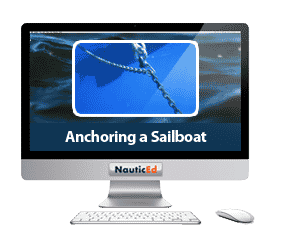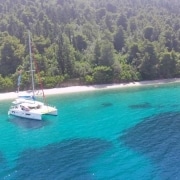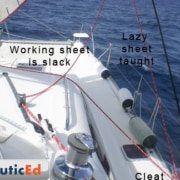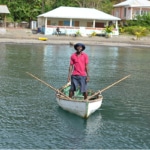Anchoring a Sailboat when Chartering
Anchoring an unfamiliar boat
Most charter boats use all chain anchor rode. The rules of anchoring say with chain you should use a 5:1 ratio. For example, for an overnight anchorage at a 4 meter depth plus 1 meter from the water line to your boat you should use 5×5 = 25 meters. If you have a 15 meter long charter boat then this is just over a boat and a half length. The trouble is no one has marked the lengths on the chain. So how do you know how much to let out?

Anchoring a Charter Boat
This thought process gets a little more impossible the deeper you go. For example 15 meters deep (50 ft) you’d need to lay 16×5=80 meters (250 ft). Your charter boat does not come with this much chain/rode and nor do most boats for that matter. Typically you’ll have a maximum of 50 meters onboard. Thus at deeper depths the 5:1 rule needs to be relaxed a little to accommodate or better yet only anchor in shallower waters. The most important thing is that there needs to be plenty of chain, at least a full boat length laying on the sea floor during a strong gust condition. This ensures that the anchor is always being pulled horizontally across the sea floor and thus making the anchor dig in more rather than getting pulled upwards (and out of its hold of the bottom).
When chartering, the anchor chain is frustratingly never marked for lengths. Here’s what we do. Take with you some plastic tie-wraps. On your first anchoring, swim the anchor after you have settled and you feel it is a good length of payout. Ensure that there is plenty of chain laying on the ocean floor. When you are satisfied with the lay, mark the chain with one of your tie-wraps remembering the depth that this is good for. Mark it prior to letting out the bridle/snubber so that next time this is where you stop the paying out – then attach the bridle/snubber and pay out enough to make the bridle/snubber do its work. As you anchor at different depths you can attach different numbers of tie wraps. We attached 1 tie wrap at a comfortable 3 meter depth and then 2 tie wraps at a comfortable 5 meter depth. This made it so we would not have to snorkel it every time and be confident that what we were letting out would be fine.
See our video we shot in Martinique of our anchor chain laying on the ocean floor.
Anchoring Process
Motoring into wind the drop spot is selected. The helmsperson and the foredeck crewperson work in unison to let away the anchor. The foredeck crewperson holds their hand up palm facing the helmsperson to indicate to stop the boat dead in the water. The anchor is lowered until it hits the bottom and then the foredeck crewperson points to the helmsperson to back the boat away. The chain is paid out at a rate to allow the chain to lay in a straight line on the ocean floor. When enough has been paid out, the foredeck crew person closes fist to indicate to stop the engines and allow the boat to continue drifting back. This will load up the anchor allowing it to set from the momentum of the boat. The bridle or snubber line is attached and the job is done. After this, it is important to sit and wait for any signs of slipping backwards. Preferably snorkel the anchor every time.
We also used the App – DragQueen Anchor Alarm which is an anchor watch alarm. This alarm will definitely wake you in the night no worries. It did us – we had the tolerance set to low for swing.
We highly recommend the NauticEd Anchoring Course. You will learn the best types of anchors and ones to dump and make into lawn art. What types are best for each bottom type. Bridles and snubbers, The course was written by Alex and Daria Blackwell who have dozens of years of global sailing. They’ve anchored in more bays than most of us have had hot dinners. The Anchoring Course is a requirement for the Bareboat Charter Master Certification – and rightly so!
Take the NauticEd Anchoring Course now.












